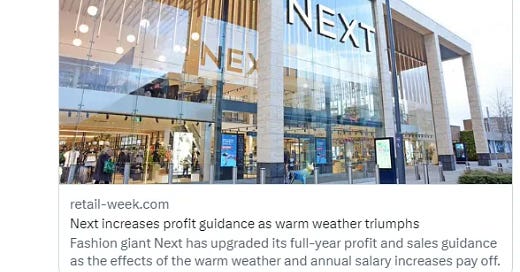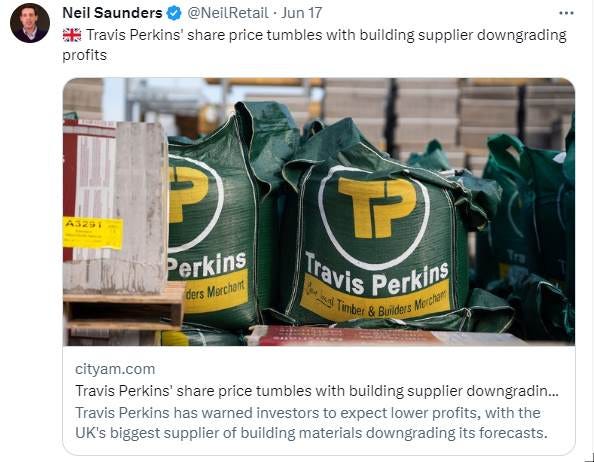Anyone in a consumer-facing business knows that any given day or week will deliver results which are driven by a complex mix of factors. This last few weeks have been a live example of that, as illustrated by this tale of two tweets:
What’s happened? A long period of hot dry weather has delivered in spades for some types of retailer (those desperate to get you to finally buy summer clothes, for example) and worked against those who want you to spend instead on boring house-based projects.
But underneath all this weather-related variation, every retailer at the moment is trying to process a much more complicated analysis - what is really happening to the UK consumer in this incredibly challenging economy. When is the cost of living crisis going to become really visible in shopping baskets which have, if we are honest, probably held up better than everyone expected coming out of Covid and through Ukraine and Truss?
There is a sense that many retailers I speak to have that Covid created something of a 2-tier consumer society - some people were hit really hard financially and have all but disappeared from discretionary spending, whilst others fared much better and even increased their savings as a result of not going out or on holiday. It is, the argument goes, that second group who have kept retail tills ticking over.
You’ll have your own views on the political acceptability of that widening wealth disparity, but whatever you think about that, it also creates a pressing question for us as business leaders - when might that ‘fortunate’ group who did well from Covid run out of money or get pulled back by economic headwinds? The answer, I suspect, will come from mortgages.
The text below is recycled from a post I wrote almost a year ago, but it remains, I think, an accurate analysis of our current situation illustrating the vulnerability of even a very superficially affluent family.
Let's consider Tom and Joanna, a hypothetical middle class UK couple in the 9th (second highest) decile of wealth. ONS wealth stats tell us that Tom and Joanna have net wealth of just over £1m. All is well, then, yes?
Not so fast. Let's take a closer look at that figure. Firstly, £520k of it is pension assets. A huge cushion for the future but they are in their 40s, so it isn't accessible yet.
The next big block is their NET property wealth, which is about £350k. Also a great asset to have, but I'm willing to bet their house is worth more than that, especially in the South East, so that means they have a big mortgage, netting off the full value of their house.
To complete the picture, they have physical wealth (stuff) of about £80k and financial wealth (cash in the bank less loans) about the same. And that's where it gets interesting.
Because even with quite high annual incomes, if they've locked themselves into spending almost everything they earn (holidays, second homes, school fees, the inevitable ski trip) then that £80k of actual financial wealth will start to look a bit vulnerable to them.
Firstly, remember that mortgage - what happens as interest rates rise? What happens when all those expenditures start to be lifted by inflation? Tom and Joanna are going to have to cut back on their spending, and that's where they impact the rest of us.
As I said at the time, the purpose of this analysis is not to try to generate sympathy for poor rich Tom and Joanna - I’m sure they will be fine.
But it does illustrate the impact of the economic times we are now living in. Given that their ‘net’ property wealth is £350k, it is perfectly plausible that this typical family from the second highest wealth decile could have more than £500k in mortgage outstanding. And the cost of that mortgage, if they are one of those families due to renew their fixed rate, is now DOUBLE what it was when I wrote this analysis 10 months ago.
So retailers looking at their performance right now are trying to untangle a huge muddle - the weather, the impact of 3 bank holidays in one month in May, the impact of the fact that holiday payments and other summer expenditures are coming due, the (offsetting) impact of wage settlements highlighted by Next in their profit upgrade and many sector-specific factors too.
But underneath all of these arguably transient factors, they are looking hard to see whether Tom and Joanna, and millions of consumers who are considerably less wealthy than they are, start to rein in their spending even more.
That’s the point of interest rate rises, of course, from the macro-economist’s point of view. But get that economic adjustment even slightly wrong, and we are in for a tough winter.






I like the way this moves the question of 'cost-of-living' towards being real - and implictly asks the question of 'What is the impact on Tom and Joanna's spending in different types of retail'.
Only implicitly, mind you... I wonder if there is a full study of different income consumers and the impact on their spending on different things.
Presumably some areas of discretionary spending should be very scared. But I know from experience that some things that you think are 'discretionary' turn out to be things that people hold on to tightly.
Hi Ian,
It is a very scary reality for the majority of people with mortgages, especially the ones that stretched to buy during COVID on short-term (2-year fixed deals) as a result of the low interest rates, low energy prices & extremely low (or even 0) stamp duty.
At the time, it seemed great but I always thought it would create a false economy & ramifications could potentially be as bad as 2008!
I'm not sure what the answer is to be honest... I'd probably be an economist & not a recruiter if that were the case :-)
Hopefully, the retailers in the industries which have flourished have saved for the rainy day, because I think it might be a stormy few years...